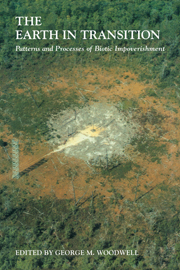Book contents
- Frontmatter
- Contents
- Preface
- Acknowledgments
- List of Contributors
- Part I Global Change and the Patterns of Impoverishment
- 1 The Earth under Stress: A Transition to Climatic Instability Raises Questions about Patterns of Impoverishment
- 2 The Experimental Impoverishment of Natural Communities: Effects of Ionizing Radiation on Plant Communities, 1961 – 1976
- 3 Air Pollution and Temperate Forests: Creeping Degradation
- 4 The Long-Term Effects of Air Pollutants on Lichen Communities in Europe and North America
- 5 Biotic Impoverishment in Northern Peatlands
- 6 Climatic Change and the Survival of Forest Species
- 7 The Atmosphere and the Future of the Biosphere: Points of Interactive Disturbance
- Part II Chronic Disturbance and Natural Ecosystems: Forests
- Part III Chronic Disturbance and Natural Ecosystems: Woodlands, Grasslands, and Tundra
- Part IV Chronic Disturbance and Natural Ecosystems: Aquatic and Emergent Ecosystems
- Part V Conclusion: Steps toward a World That Runs Itself
- Name Index
- Subject Index
4 - The Long-Term Effects of Air Pollutants on Lichen Communities in Europe and North America
Published online by Cambridge University Press: 24 November 2009
- Frontmatter
- Contents
- Preface
- Acknowledgments
- List of Contributors
- Part I Global Change and the Patterns of Impoverishment
- 1 The Earth under Stress: A Transition to Climatic Instability Raises Questions about Patterns of Impoverishment
- 2 The Experimental Impoverishment of Natural Communities: Effects of Ionizing Radiation on Plant Communities, 1961 – 1976
- 3 Air Pollution and Temperate Forests: Creeping Degradation
- 4 The Long-Term Effects of Air Pollutants on Lichen Communities in Europe and North America
- 5 Biotic Impoverishment in Northern Peatlands
- 6 Climatic Change and the Survival of Forest Species
- 7 The Atmosphere and the Future of the Biosphere: Points of Interactive Disturbance
- Part II Chronic Disturbance and Natural Ecosystems: Forests
- Part III Chronic Disturbance and Natural Ecosystems: Woodlands, Grasslands, and Tundra
- Part IV Chronic Disturbance and Natural Ecosystems: Aquatic and Emergent Ecosystems
- Part V Conclusion: Steps toward a World That Runs Itself
- Name Index
- Subject Index
Summary
Editor's Note: Lichens, many of them, are surface dwellers. They have evolved to occupy, among other places, the surface of rocks, the surface of the soil, the bark of trees. These surfaces offer some of the most difficult habitats for life, habitats marked by extremes. The surface of a rock, for example, may bake in the sun during the day and rise in temperature to 70° Celsius or more, dropping at night to freezing or below. Similar extremes in water availability accompany such changes. Yet such habitats may support communities of lichens that garner water and nutrients directly through the surfaces of their thalli. Despite the apparent hardiness of lichens, their populations have long been considered sensitive indicators of air pollution: certain lichens appear to be particularly vulnerable to air pollution and their vigor appears to offer potential as an early index of impoverishment.
The difficulty is that under disturbance the populations are ephemeral: they often disappear quickly and the index becomes neither morbidity nor other active change, but mere absence. Professor Hawksworth warns, to add to the difficulty, that it is not always appropriate to transfer experience with lichen communities from one place to another. Nonetheless, he provides compelling documentation of the sensitivity of lichen populations to airborne pollutants. The effects are unquestionably impoverishment, a reduction in diversity that is virtually universal and that applies in particular to fruticose and foliose, less to crustose, lichens.
- Type
- Chapter
- Information
- The Earth in TransitionPatterns and Processes of Biotic Impoverishment, pp. 45 - 64Publisher: Cambridge University PressPrint publication year: 1991
- 4
- Cited by



